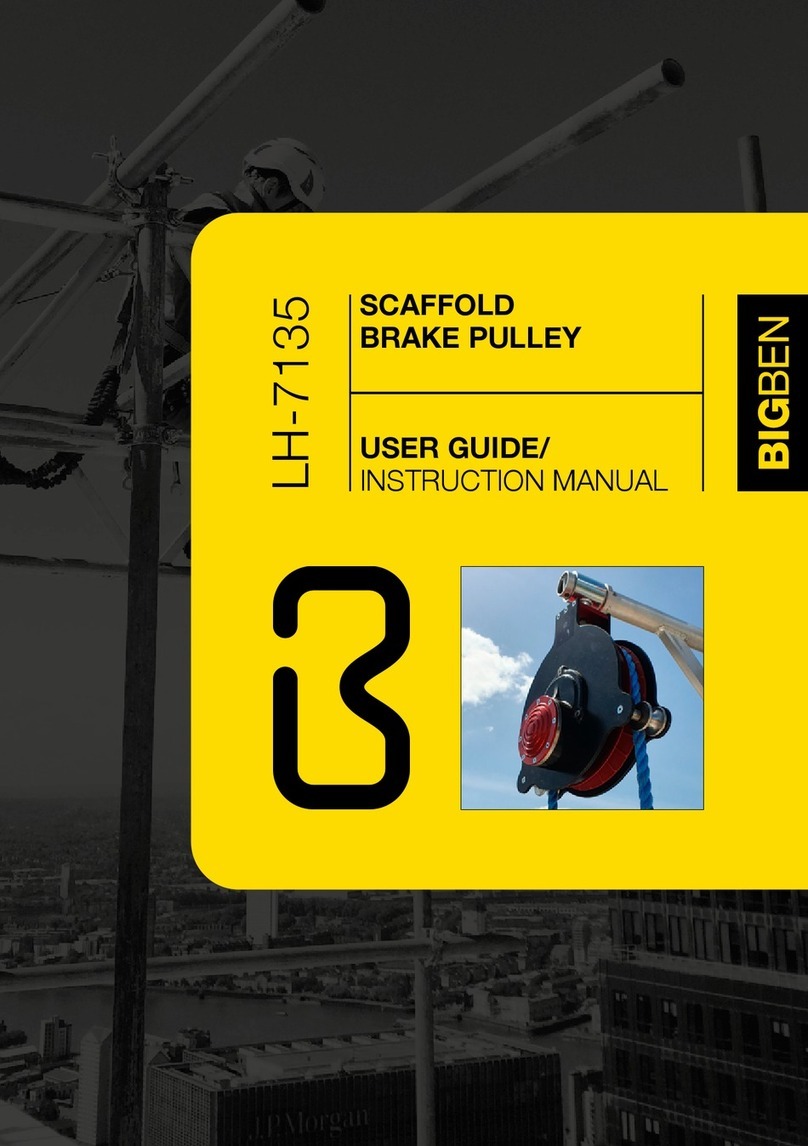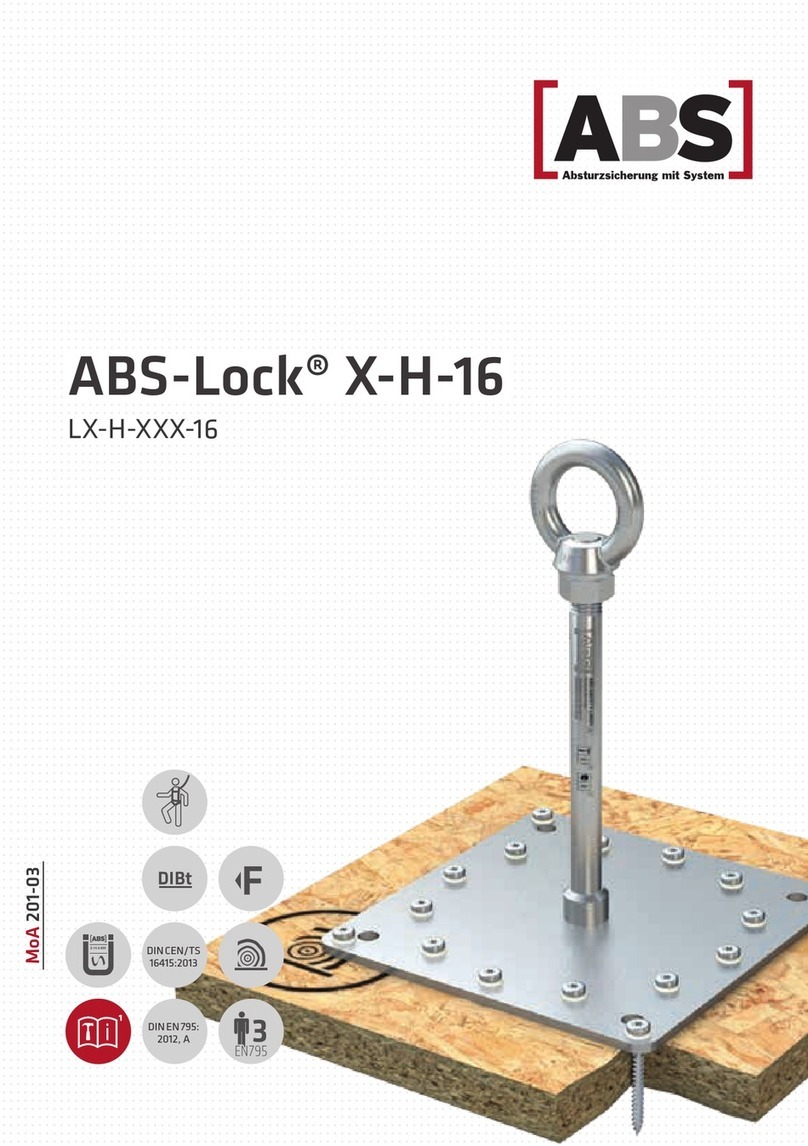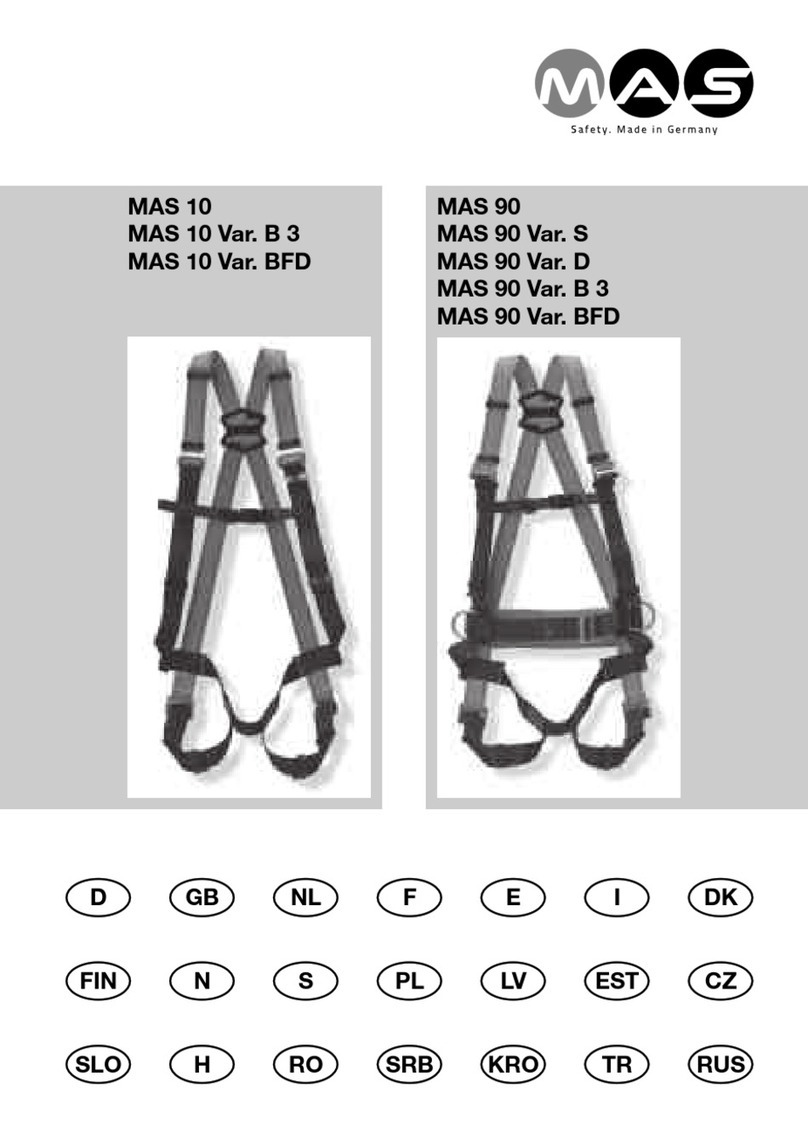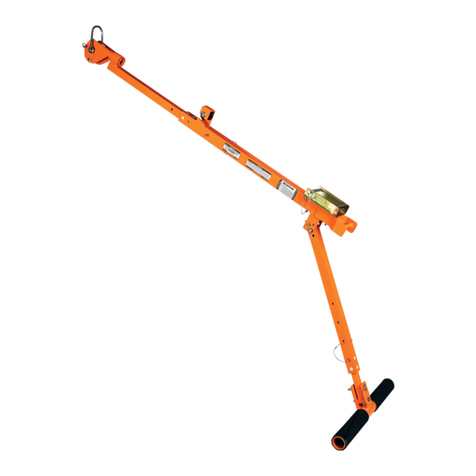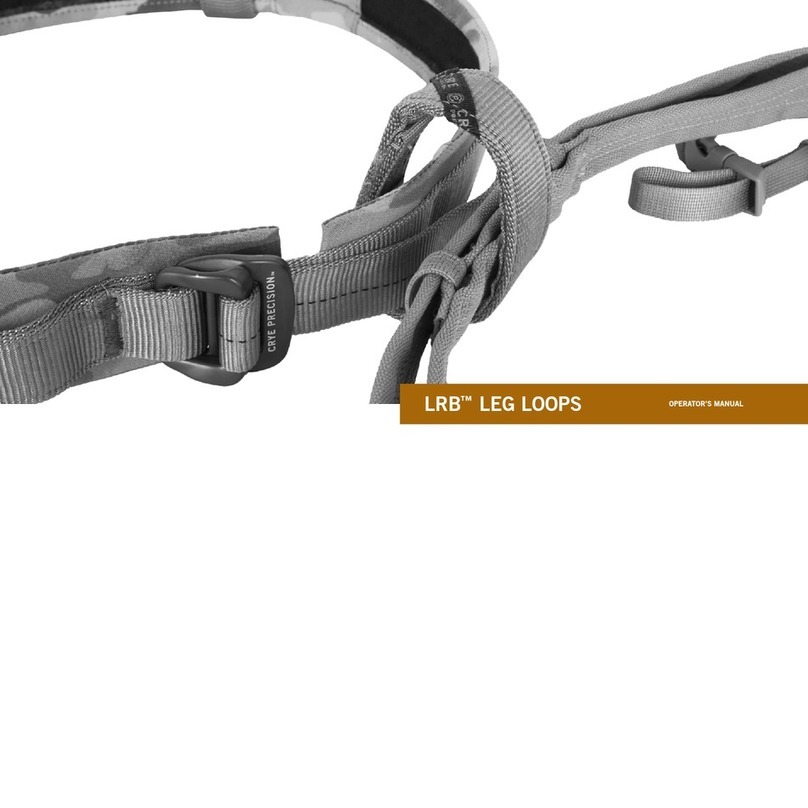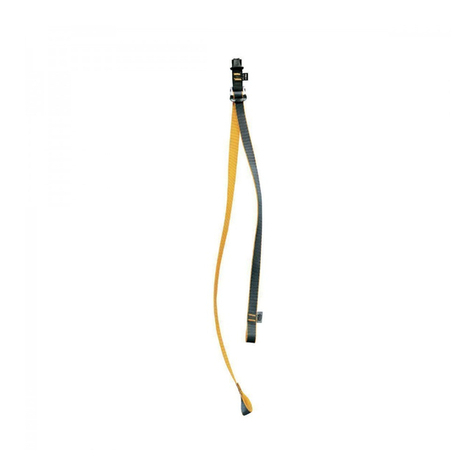Elcon HiD 2000 Series Operator's manual

SERIES HiD 2000
INTRINSIC SAFETY ISOLATORS
User Instruction Manual
ELCON INSTRUMENTS
I/O Interface, Intrinsic Safety and Solutions

Warning: this manual is copyright of Elcon Instruments with all rights reserved.
This manual may not be copied, in whole or in part, without the written
consent of Elcon Instruments.
Elcon Instruments reserves the right to make changes of this manual
without notice.
• RD-ZIP-004
DOC.TECN. Ins.Man. IM-ENG-111/GB-A2-PN991169
SERIES HiD 2000 INTRINSIC SAFETY ISOLATORS
User Instruction Manual
ELCON INSTRUMENTS
I/O Interface, Intrinsic Safety and Solutions

I
Table of contents
1Introduction..................................................................................................................................................1-1
1.1 Overview ..............................................................................................................................................1-1
1.2 Explanation of Contents........................................................................................................................1-1
1.3 Key Features ........................................................................................................................................ 1-2
1.4 Hazardous Area Interfacing...................................................................................................................1-2
2Specifications ..............................................................................................................................................2-1
2.1 Product Selection..................................................................................................................................2-1
2.2 Ordering Information.............................................................................................................................2-2
2.3 Mechanical Specifications.....................................................................................................................2-3
2.4 Safety Specifications ............................................................................................................................ 2-4
2.5 Approvals and Markings........................................................................................................................2-5
2.6 Electrical Specifications - general .........................................................................................................2-6
2.7 Electrical Specifications - modules........................................................................................................2-7
2.7.1 HiD 2025/2026 Repeater Power Supply, Smart Transmitter........................................................... 2-7
2.7.2 HiD 2025SK/2026SK Repeater Power Supply, Smart Transmitter..................................................2-8
2.7.3 HiD 2029/2030 Repeater Power Supply, Smart Tx, Fully Floating..................................................2-9
2.7.4 HiD 2029SK/2030SK Repeater Power Supply, Smart Tx, Fully Floating................................................ 2-10
2.7.5 HiD 2031/2032 I/P Driver, Bus Powered....................................................................................... 2-11
2.7.6 HiD 2033/2034 I/P Driver, Loop Powered..................................................................................... 2-12
2.7.7 HiD 2035/2036 Loop powered Isolator for Fire and Smoke Detectors........................................... 2-13
2.7.8 HiD 2037/2038 I/P Driver, Bus Powered, Smart ........................................................................... 2-14
2.7.9 HiD 2061/2062 Temperature Converter, mV/TC........................................................................... 2-15
2.7.10 HiD 2071/2072 RTD/Potentiometer Converter.............................................................................. 2-16
2.7.11 HiD 2822/2824 Switch/Proximity Detector Repeater, Relay Output .............................................. 2-17
2.7.12 HiD 2842/2844 Switch/Proximity Detector Repeater, Open Coll. Output............................................ 2-18
2.7.13 HiD 2871/2872 Solenoid/Alarm Driver, Loop or Bus Powered ...................................................... 2-19
2.7.14 HiD 2873/2874 Solenoid/Alarm Driver, Bus Powered................................................................... 2-20
2.7.15 HiD 2875/2876 Solenoid/Alarm Driver, Loop or Bus Powered ...................................................... 2-21
2.7.16 HiD 2877/2878 Solenoid/Alarm Driver, Bus Powered................................................................... 2-22
2.7.17 HiD 2881 Solenoid/Alarm Driver, Loop or Bus Powered, IIB Output ............................................. 2-23
3System Operation........................................................................................................................................ 3-1
3.1 General description of the system......................................................................................................... 3-1
3.2 System design considerations...............................................................................................................3-1
3.3 Wiring of intrinsically safe circuits......................................................................................................... 3-1
3.4 Grounding information ..........................................................................................................................3-2
4Installation and Configuration.......................................................................................................................4-1
4.1 Unpacking.............................................................................................................................................4-1
4.2 Storage.................................................................................................................................................4-1
4.3 Operating environment .........................................................................................................................4-1
4.4 Installation ............................................................................................................................................4-2
4.5 Board polarisation................................................................................................................................. 4-2
4.6 Configuration ........................................................................................................................................4-2
4.7 Electrical Connections...........................................................................................................................4-3
4.8 EMC Guidelines....................................................................................................................................4-3
4.9 Heat Dissipation and Thermal Behaviour ..............................................................................................4-3
4.10 Cabinet Heat-Dissipation....................................................................................................................... 4-5
5Unit Operation ............................................................................................................................................. 5-1
5.1 HiD 2025/2026......................................................................................................................................5-1
5.2 HiD 2025SK/2026SK............................................................................................................................. 5-3
5.3 HiD 2029/2030......................................................................................................................................5-5
5.4 HiD 2029SK/2030SK............................................................................................................................. 5-7
5.5 HiD 2031/2032......................................................................................................................................5-9
5.6 HiD 2033/2034.................................................................................................................................... 5-11
5.7 HiD 2035/2036.................................................................................................................................... 5-13
5.8 HiD 2037/2038.................................................................................................................................... 5-15
5.9 HiD 2061/2062.................................................................................................................................... 5-17
5.10 HiD 2071/2072.................................................................................................................................... 5-20
5.11 HiD 2822/2824.................................................................................................................................... 5-23
5.12 HiD 2842/2844.................................................................................................................................... 5-26

II
5.13 HiD 2871/2872.................................................................................................................................... 5-29
5.14 HiD 2873/2874.................................................................................................................................... 5-32
5.15 HiD 2875/2876.................................................................................................................................... 5-35
5.16 HiD 2877/2878.................................................................................................................................... 5-38
5.17 HiD 2881............................................................................................................................................. 5-41
6Servicing .....................................................................................................................................................6-1
6.1 Maintenance......................................................................................................................................... 6-1
6.2 Functional Check & Troubleshooting.....................................................................................................6-1
6.2.1 HiD 2025/2026............................................................................................................................... 6-3
6.2.2 HiD 2025SK/2026SK......................................................................................................................6-4
6.2.3 HiD 2029/2030............................................................................................................................... 6-5
6.2.4 HiD 2029SK/2030SK......................................................................................................................6-6
6.2.5 HiD 2031/2032............................................................................................................................... 6-7
6.2.6 HiD 2033/2034............................................................................................................................... 6-8
6.2.7 HiD 2035/2036............................................................................................................................... 6-9
6.2.8 HiD 2037/2038............................................................................................................................. 6-10
6.2.9 HiD 2822/2824............................................................................................................................. 6-11
6.2.10 HiD 2842/2844............................................................................................................................. 6-13
6.2.11 HiD 2871/2872............................................................................................................................. 6-15
6.2.12 HiD 2873/2874............................................................................................................................. 6-17
6.2.13 HiD 2875/2876............................................................................................................................. 6-19
6.2.14 HiD 2877/2878............................................................................................................................. 6-21
6.2.15 HiD 2881...................................................................................................................................... 6-23
6.3 Warranty............................................................................................................................................. 6-25
7Glossary ......................................................................................................................................................7-1
8Index ...........................................................................................................................................................8-1
9Appendix A..................................................................................................................................................9-1
9.1 HiD 2061/HiD 2062 Input Range Configurations....................................................................................9-1
9.1.1 Input type “mV”.............................................................................................................................. 9-1
9.1.2 Input type thermocouple “B”........................................................................................................... 9-2
9.1.3 Input type thermocouple “E”........................................................................................................... 9-3
9.1.4 Input type thermocouple “J”............................................................................................................ 9-4
9.1.5 Input type thermocouple “K”........................................................................................................... 9-5
9.1.6 Input type thermocouple “N”...........................................................................................................9-6
9.1.7 Input type thermocouple “R”...........................................................................................................9-7
9.1.8 Input type thermocouple “S”........................................................................................................... 9-7
9.1.9 Input type thermocouple “T”........................................................................................................... 9-8
9.1.10 Input type thermocouple “L” ........................................................................................................... 9-9
9.2 Thermocouple / mV Calibration........................................................................................................... 9-10
9.2.1 Equipment required...................................................................................................................... 9-10
9.2.2 Thermocouple or mV Input range modification............................................................................. 9-10
9.2.3 Thermocouple Input Range Calibration........................................................................................ 9-10
9.2.3.1 Copper Wires Calibration.......................................................................................................... 9-11
9.2.3.2 Compensating Wires Calibration .............................................................................................. 9-11
9.2.3.3 0 °C Reference Junction Calibration......................................................................................... 9-11
9.2.3.4 TC Calibrator with auto internal RJ compensation Calibration................................................... 9-12
9.2.3.5 TC Calibrator with auto remote RJ compensation Calibration ................................................... 9-12
9.2.4 mV Input Range Calibration......................................................................................................... 9-12
10 Appendix B................................................................................................................................................ 10-1
10.1 HiD 2071/HiD 2072 Input Range Configurations.................................................................................. 10-1
10.1.1 Input type RTD Pt100 Ω............................................................................................................... 10-1
10.1.2 Input type Potentiometer.............................................................................................................. 10-2
10.2 RTD / POT Calibration........................................................................................................................ 10-3
10.2.1 Equipment required...................................................................................................................... 10-3
10.2.2 RTD or POT Input range modification.......................................................................................... 10-3
10.2.3 Pt 100 ΩRTD Input range calibration........................................................................................... 10-3
10.2.4 Other types of RTD (to be specified when ordering)..................................................................... 10-3
10.2.5 POT Input range calibration ......................................................................................................... 10-4

1-1
1Introduction
This manual is intended to provide guidance for the installation, operation and maintenance of the HiD 2000 range
of intrinsic safety isolators.
To avoid damage, failure or improper operation, carefully read this manual before installing and operating the unit.
This manual and the related equipment should not be used by untrained personnel unless they are fully acquainted
with the principles of intrinsically safe system.
Elcon Instruments has published a complete tutorial entitled “Guide to Intrinsic Safety” covering most aspect of
intrinsic safety. The book can be obtained from Elcon Instruments free of charge.
1.1 Overview
The Elcon HiD 2000 Series is designed to be used in connection with process instrumentation system and consist
of a range of compact I.S. isolating interface modules to handle the input and output signals of a process plant.
Moreover a range of standard and custom made Termination Boards are available where the modules can be
plugged and quickly secured.
With this new full line of modular plug-in I.S. isolator a significant cost reduction is achieved in project planning,
plant design commissioning and service.
The module pack one, two or four isolated channels into a compact housing which can be inserted or removed
from the Termination Board without disturbing any of the wiring, no specialist knowledge is required, thereby
eliminating a frequent source of errors. The new “Quick Lok” method of fixing the module without the need for
tools reduces installation time and is very ease to operate. Pushing down a tab on each side of the module rotates
a securing foot which locks the unit to the Termination Board; to remove the modules simply lift the tabs. For
servicing, only the defective module needs to be removed and the replacement module plugged into the
Termination Board and locked by the quick mechanism. No special knowledge is required, the signal cables don’t
need to be detached and re-connected, eliminating a frequent source of errors.
Polarisation on the Board securely prevents modules from being swapped inadvertently.
The HiD 2000 Series product range has:
•high packing density, due to innovative circuit design using advanced surface mount components
•high performance, with high signal transfer accuracy and repeatability, low consumption, low heat
dissipation
•wide functionality, with a wide range of I/O signals, galvanic isolation, line fault alarm
•HiD 2000 Series products are Intrinsic Safety Certified according to CENELEC, CSA, FM, GOST, SEV,
SABS, SAA and other world-wide standards. Moreover, they meet European directives on EMC, and all
modules carry the CE marking.
1.2 Explanation of Contents
This instruction manual describes how to install, connect, check and maintain the HiD range of intrinsic safety
isolators:
•section 2 supplies the technical specifications of the units in a concise form
•section 3 describes system operation.
•section 4 describes how to install and configure the HiD modules
•section 5 shows how to operate the units
•section 6 deals with maintenance and troubleshooting issues
A Glossary and an Analytical Index for easy reference to topics complete the document.
This isolators manual is intended to be read and used in conjunction with the Termination Board User
Instruction Manual (IM-ENG 112/GB).

1-2
1.3 Key Features
•high channel density results from innovative circuit design using surface mounted components
•high packing density, with ultra slim 4 channels 18 mm wide plug-in mounting modules, 4.5 mm per
channel
•single, dual and quadruple channels models
•high signal transfer accuracy and repeatability
•low power consumption and heat dissipation
•wide operating temperature range
•wide range of digital switches and analog I/O, including 4-20 mA, signal conversion, loop powered and
external supply configurations
•galvanic isolation to eliminate noise, ground loop problems and to provide Intrinsic Safety without a
high integrity safety earth connection
•line fault alarm detects open or short circuit of field cables
•sink or source outputs available on analog models
•configure using DIP switch located on side cover for easy field set up
•LED indication for power, signal status and line fault condition
•“Quick Lok” mechanism for easy and quickly mounting
•loop identification, coding and tagging
•accept DC power supply over a wide range (24V, -15% +25%)
1.4 Hazardous Area Interfacing
Correct and safe operation of Elcon HiD 2000 Series calls for expert installation and commissioning as well as
correct operation and meticulous maintenance.
Only those persons conversant with the installation commissioning, operation and maintenance of similar
apparatus and who has the necessary qualifications are allowed to work on HiD 2000 Series.
Make sure installation is carried out observing the safety regulations pertaining to the installation and operation of
electrical system and the directives and guidelines on explosion protection (Hazardous Area equipment should
comply with the descriptive system document).
The installation must be performed by qualified personnel, it must comply with the relevant national/international
standards (e.g. IEC 79-14, CEI 64-2, BS 5345 Pt. 4, DIN VDE 165) and in line with the established installation
rules and recommended practice (e.g. CEI 64-8, ANSI/ISA RP-12.6).
The conformity of hazardous area devices with the related system documentation must always be checked. This
instrumentation IS NOT intended for hazardous area installation, unless it is included in a proper explosion proof
enclosure which conforms to the applicable standards.
For I.S. applications, the maximum limit for AC power supply is 250 Vrms.
For more information on request Elcon will provide the manual “Guide to Intrinsic Safety”, a comprehensive
tutorial about the constraints imposed by the I.S. regulations.

2-1
2Specifications
This section lists the relevant specifications for all HiD modules. For a detailed description of unit functions and
operation, please refer to Section 5.
2.1 Product Selection
The following table shows the standard isolators available and their main features.
Field
Device Model N° of
Ch. Hazardous Area Signal Safe Area Signal Fault Bus
Output
HiD 2025
HiD 2026
1
2
4-20 mA (15.5 V) floating supply to Smart
or non Smart two wire Transmitters 4-20 mA (or 1-5 V) output isolated from
input, Smart compatible
HiD 2025/SK
HiD 2026/SK
1
2
4-20 mA (15.5 V) floating supply to Smart
or non Smart two wire Transmitters 4-20 mA load sink, isolated from input,
Smart compatible
HiD 2029
HiD 2030
1
2
4-20 mA (15.5 V) floating supply to Smart
or non Smart two or three wire Transmitters 4-20 mA (or 1-5 V) output isolated from
input and power supply, Smart compatible,
Line Fault Detection
√√
√√
HiD 2029/SK
HiD 2030/SK
1
2
4-20 mA (15.5 V) floating supply to Smart
or non Smart two or three wire Transmitters 4-20 mA load sink, isolated from input and
power supply, Smart compatible, Line Fault
Detection
√√
√√
HiD 2031
HiD 2032
1
2
4-20 mA to I/P converters, electrovalve
actuators and displays Bus powered, 4-20 mA signal from DCS,
PLC or other control device
HiD 2033
HiD 2034
1
2
4-20 mA to I/P converters, electrovalve
actuators and displays Loop Powered, 4-20 mA signal from DCS,
PLC or other control device
HiD 2035
HiD 2036
1
2
Fire and Smoke Detectors or I/P Converter Loop Powered, 1.5 to 50 mA signal from
DCS, PLC or other control device
HiD 2037
HiD 2038
1
2
4-20 mA and Smart signal to I/P
converters, electrovalve actuators and
displays
Bus powered, 4-20 mA signal from DCS,
PLC or other control device, Line Fault
Detection, Smart compatible
√√
√√
HiD 2061
HiD 2062
1
2
Thermocouple or mV 4-20 mA (or 1-5 V) output isolated from
input
HiD 2071
HiD 2072
1
2
RTD or Potentiometer 4-20 mA (or 1-5 V) output isolated from
input
HiD 2822
HiD 2824
2
4
Dry Contact or Proximity Switch DPST relay per channel, Line Fault
Detection
SPST relay per channel, Line Fault
Detection
√√
√√
HiD 2842
HiD 2844
2
4
Dry Contact or Proximity Switch 2 open-collector outputs per channel, Line
Fault Detection
1 open-collector output per channel, Line
Fault Detection
√√
√√

2-2
Field
Device Model N° of
Ch. Hazardous Area Signal Safe Area Signal Fault Bus
Output
HiD 2871
HiD 2872
1
2
40 mA at 12 V to drive solenoid valve,
audible or visual alarm (LED) Bus powered and/or loop powered,
controlled by external contact from DCS or
control device
HiD 2873
HiD 2874
1
2
40 mA at 12 V to drive solenoid valve,
audible or visual alarm (LED) Bus powered, controlled by external contact
or logic level from DCS or control device,
Line Fault Detection
√√
√√
HiD 2875
HiD 2876
1
2
40 mA at 11.2 V to drive solenoid valve,
audible or visual alarm (LED) Bus powered and/or loop powered,
controlled by external contact from DCS or
control device
HiD 2877
HiD 2878
1
2
40 mA at 11.2 V to drive solenoid valve,
audible or visual alarm (LED) Bus powered, controlled by external contact
or logic level from DCS or control device,
Line Fault Detection
√√
√√
HiD 2881 1
60 mA at 13 V to drive solenoid valve, IIB
Gas Group Bus powered and/or loop powered,
controlled by external contact or logic level
from DCS or control device, Line Fault
Detection
√√
2.2 Ordering Information
The ELCON family of HiD Intrinsic Safety Isolators are designed for simple ordering, you simply have to specify
the Model Number from the product selection table.
All user configurable units are delivered with a “default” configuration as specified in Section 2.7. For an additional
charge, Elcon can deliver units configured as specified by the customer.
Each unit is delivered with a detailed Installation Sheet containing all the information required to set up the isolator
on site.

2-3
2.3 Mechanical Specifications
Mounting Plug-in on Termination Board
Dimensions Width 18 mm
Depth 106 mm
Height 128 mm
Case material Policarbonate
Flame retardant compliant to UL 94 V2
Unit weight about 140 gr
Blister packing size Width 30 mm
Depth 145 mm
Height 165 mm
Dimensional Drawing

2-4
2.4 Safety Specifications
Terminal Safety Description Maximum External Parameters
HiD2025/2026 Cenelec (groups) USA Co (µµF) Lo (mH) L/R (µµH/ΩΩ)
Uo = 26.25 V II C A-B 0.097 4.1 58
1-4 Io = 93 mA II B C-E 0.74 16.5 230
2-5 Po = 610 mW II A D-F-G 2.51 33 470
HiD2025SK/2026SK Cenelec (groups) USA Co (µµF) Lo (mH) L/R (µµH/ΩΩ)
Uo = 26.25 V II C A-B 0.097 4.1 58
1-4 Io = 93 mA II B C-E 0.74 16.5 230
2-5 Po = 610 mW II A D-F-G 2.51 33 470
HiD2029/2030 Cenelec (groups) USA Co (µµF) Lo (mH) L/R (µµH/ΩΩ)
Uo = 26.25 V II C A-B 0.097 4.1 58
1-4 Io = 93 mA II B C-E 0.74 16.5 230
2-5 Po = 610 mW II A D-F-G 2.51 33 470
Uo = 1.2 V II C A-B
4-7 Io = 50 mA II B C-E Non energy storing apparatus connection
5-6 Po = 25 mW II A D-F-G
HiD2029SK/2030SK Cenelec (groups) USA Co (µµF) Lo (mH) L/R (µµH/ΩΩ)
Uo = 26.25 V II C A-B 0.097 4.1 58
1-4 Io = 93 mA II B C-E 0.74 16.5 230
2-5 Po = 610 mW II A D-F-G 2.51 33 470
Uo = 1.2 V II C A-B
4-7 Io = 50 mA II B C-E Non energy storing apparatus connection
5-6 Po = 25 mW II A D-F-G
HiD2031/2032 Cenelec (groups) USA Co (µµF) Lo (mH) L/R (µµH/ΩΩ)
Uo = 26.25 V II C A-B 0.097 4.1 58
1-4 Io = 93 mA II B C-E 0.74 16.5 230
2-5 Po = 610 mW II A D-F-G 2.51 33 470
HiD2033/2034 Cenelec (groups) USA Co (µµF) Lo (mH) L/R (µµH/ΩΩ)
Uo = 26.25 V II C A-B 0.097 4.1 58
1-4 Io = 93 mA II B C-E 0.74 16.5 230
2-5 Po = 610 mW II A D-F-G 2.51 33 470
HiD2035/2036 Cenelec (groups) USA Co (µµF) Lo (mH) L/R (µµH/ΩΩ)
Uo = 26.25 V II C A-B 0.097 4.1 58
1-4 Io = 93 mA II B C-E 0.74 16.5 230
2-5 Po = 610 mW II A D-F-G 2.51 33 470
HiD2037/2038 Cenelec (groups) USA Co (µµF) Lo (mH) L/R (µµH/ΩΩ)
Uo = 26.25 V II C A-B 0.097 4.1 58
1-4 Io = 93 mA II B C-E 0.74 16.5 230
2-5 Po = 610 mW II A D-F-G 2.51 33 470
HiD2061/2062 Cenelec (groups) USA Co (µµF) Lo (mH) L/R (µµH/ΩΩ)
Uo = 13.1 V II C A-B 1.97 70 520
1-4, 7-8 Io = 22 mA II B C-E 13.8 250 1860
2-3, 5-6 Po = 72 mW II A D-F-G 60 580 4300
HiD2071/2072 Cenelec (groups) USA Co (µµF) Lo (mH) L/R (µµH/ΩΩ)
Uo = 13.1 V II C A-B 1.97 70 520
7-1-4-8 Io = 22 mA II B C-E 13.8 250 1860
3-2-5-6 Po = 72 mW II A D-F-G 60 580 4300

2-5
Terminal Safety Description Maximum External Parameters
HiD2822/2824 Cenelec (groups) USA Co (µµF) Lo (mH) L/R (µµH/ΩΩ)
Uo = 13.1 V II C A-B 1.97 70 520
1-4, 2-5 Io = 22 mA II B C-E 13.8 250 1860
3-6, 7-8 Po = 72 mW II A D-F-G 60 580 4300
HiD2842/2844 Cenelec (groups) USA Co (µµF) Lo (mH) L/R (µµH/ΩΩ)
Uo = 13.1 V II C A-B 1.97 70 520
1-4, 2-5 Io = 22 mA II B C-E 13.8 250 1860
3-6, 7-8 Po = 72 mW II A D-F-G 60 580 4300
HiD2871/2872 Cenelec (groups) USA Co (µµF) Lo (mH) L/R (µµH/ΩΩ)
Uo = 26.25 V II C A-B 0.097 3 50
7-1-4 Io = 110 mA II B C-E 0.74 11 200
6-2-5 Po = 720 mW II A D-F-G 2.51 22 400
HiD2873/2874 Cenelec (groups) USA Co (µµF) Lo (mH) L/R (µµH/ΩΩ)
Uo = 26.25 V II C A-B 0.097 3 50
1-4 Io = 110 mA II B C-E 0.74 11 200
2-5 Po = 720 mW II A D-F-G 2.51 22 400
HiD2875/2876 Cenelec (groups) USA Co (µµF) Lo (mH) L/R (µµH/ΩΩ)
Uo = 26.25 V II C A-B 0.097 4.1 58
7-1-4 Io = 93 mA II B C-E 0.74 16.5 230
6-2-5 Po = 610 mW II A D-F-G 2.51 33 470
HiD2877/2878 Cenelec (groups) USA Co (µµF) Lo (mH) L/R (µµH/ΩΩ)
Uo = 26.25 V II C A-B 0.097 4.1 58
1-4 Io = 93 mA II B C-E 0.74 16.5 230
2-5 Po = 610 mW II A D-F-G 2.51 33 470
HiD2881 Cenelec (groups) USA Co (µµF) Lo (mH) L/R (µµH/ΩΩ)
Uo = 26.25 V
1-4 Io = 184 mA II B C-E 0.5 4.5 127
Po = 1.2 W II A D-F-G 1.9 8.5 241
2.5 Approvals and Markings
The HiD series complies with all the mandatory European standards and bears the CE marking.
AUTHORITY CERTIFICATE/FILE NO. STANDARD APPROVED FOR
CESI EX-97.D.054
EX-97.D.055 EN 50.020
EN 50.014 [EEx ia] IIC
CSA Pending C 22.2 No. 157
C 22.2 No. 142 CL. I, II, III;
Div 1; Gr. A to G
FM Pending FM Cl. No. 3610 Entity
FM Cl. No. 3600
FM Cl. No. 3611
Cl. I, II, III;
Div 1; Gr. A to G
Cl. I, II, III; Div 2
SCS EX 97Y4109X BS 6941:1988 Ex N IIC T4
SAA Pending AS 2380.1
AS 2380.7 [Ex ia] IIC
Certifications to other world wide standards are in existence or pending.

2-6
2.6 Electrical Specifications - general
This section lists the characteristics that apply to all HiD modules in the product range. For details about the
individual module features, please refer to Section 5
Reference Conditions
Temperature 23 °C (74 °F)
Relative humidity 50 %
Nominal supply voltage 24 Vdc(20.4 to 30V)
Load where applicable 250 Ω
Full scale value 20 mA
Environmental Conditions Limits
Operating Temperature(derating can apply) 0 to 60 °C (32 to 140 °F)
Storage temperature -20 to 70 °C (-4 to 158 °F)
Relative humidity
(non condensing - up to 35 °C – 95 °F) 5to 90 %
Isolation
Hazardous Area to Safe Area 1500 Vrms for 1 minute
Safe Area input – output circuits to supply
circuit (where applicable) 250 Vrms for 1 minute
Hazardous area to
Hazardous Area channels 500 Vrms for 1 minute
Electromagnetic Compatibility (EMC)
Phenomena Family Standards Test Method Standards
Generic Emission EN 50.081-2
Radiated and conducted emission EN 50.011
Generic Immunity EN 50.082-2
RF Radiated ENV 50140
RF Radiated 900 MHz ENV 50204
RF Conducted ENV 50141
Electrostatic Discharge (ESD) EN 61000-4-2
Electric Fast Transient / Burst EN 61000-4-4
N.B. these EMC specifications satisfy the CE marking requirements
Mounting
Modules plug-in, no tools required for replacement
All HiD devices are protected against reverse polarity power supply connection (on Termination Board).
Common to all relevant modules is the provision of a separate fault output which is bussed on the Termination
Boards to provide a collective signal per interface assembly.
Protection class IP30 (IEC 529)

2-7
2.7 Electrical Specifications - modules
This section include the detailed electrical specifications for each module type.
All values are typical and at reference conditions unless otherwise specified.
2.7.1 HiD 2025/2026 Repeater Power Supply, Smart Transmitter
DC supply
Current consumption 50 mA @ 24 V, 20 mA output (per channel)
Power dissipation 0.8 W @ 24 V (per channel)
Hazardous Area Signal (Input)
Signal range 4-20 mA Overload limited at 26 mA typ.
Voltage available for transmitter and lines 15.5 V min @ 20 mA
Ripple content 10 mVrms
Safe Area Signal (Output)
User selectable 4-20 mA or 1-5 V 1-5 V on 250 Ωinternal shunt
Ripple content 10 mVrms on 250 Ωload required for communications
Load 0 to 650 Ω
Load effect ≤0.1 % of full scale from 0 to 650 Ω
Frequency response of comm. Channel
Tx to output 0.5 to 40 KHz within 3 dB, (-6 dB @ 100 KHz)
Output to Tx 0.5 to 40 KHz within 3 dB, (-6 dB @ 100 KHz)
Response time 40 msec 10 to 90% step change
Performance at Reference Conditions
Calibration accuracy < ±0.1 % of full scale (Current output)
Linearity < ±0.1 % of full scale
Temperature drift < ±0.01 %/°C
Selector switches Output 4-20 mA or
1-5 V (250 Ω, 0.1 % internal shunt)
Factory set as 4-20 mA
LED Indicators Power ON Green

2-8
2.7.2 HiD 2025SK/2026SK Repeater Power Supply, Smart Transmitter
DC supply
Current consumption 50 mA @ 24 V, 20 mA output (per channel)
Power dissipation 1.3 W @ 24 V supply, 24 V external supply from
DCS or PLC (per channel)
Hazardous Area Signal (Input)
Signal range 4-20 mA Overload limited at 26 mA typ.
Voltage available for transmitter and lines 15.5 V min @ 20 mA
Ripple content 10 mVrms
Safe Area Signal (Output)
Sink mode from external supply 4-20 mA Overload limited at 26 mA typ.
Working voltage range 7-30 V
Frequency response of comm. Channel
Tx to output 0.5 to 40 KHz within 3 dB, (-6 dB @ 100 KHz)
Output to Tx 0.5 to 40 KHz within 3 dB, (-6 dB @ 100 KHz)
Response time 40 msec 10 to 90% step change
Performance at Reference Conditions
Calibration accuracy < ±0.1 % of full scale
Linearity < ±0.1 % of full scale
Temperature drift < ±0.01 %/°C
Selector switches None
LED Indicators Power ON Green

2-9
2.7.3 HiD 2029/2030 Repeater Power Supply, Smart Tx, Fully Floating
DC supply
Current consumption 60 mA @ 24 V, 20 mA output (per channel)
Power dissipation 1.05 W @ 24 V (per channel)
Hazardous Area Signal (Input)
Voltage available for transmitter and lines 15.5 V min @ 20 mA
Ripple content 10 mVrms
Input range 4-20 mA Overload limited at 26 mA typ.
Input resistance for current source 40 Ω
Safe Area Signal (Output)
User selectable 4-20 mA or 1-5 V 1-5 V on 250 Ωinternal shunt
Ripple content 10 mVrms on 250 Ωload required for communications
Load 0 to 650 Ω
Load effect ≤0.1 % of full scale from 0 to 650 Ω
Frequency response of comm. Channel
Tx to output 0.5 to 40 KHz within 3 dB, (-6 dB @ 100 KHz)
Output to Tx 0.5 to 40 KHz within 3 dB, (-6 dB @ 100 KHz)
Response time 70 msec 10 to 90% step change
Performance at Reference Conditions
Calibration accuracy < ±0.1 % of full scale (Current output)
Linearity < ±0.05 % of full scale
Temperature drift < ±0.01 %/°C
No fault detection > 1 mA or < 23.5 mA input current
Fault detection < 0.2 mA or > 24 mA Input current
Selector switches Output 4-20 mA or
1-5 V (250 Ω, 0.1 % internal shunt)
Factory set as 4-20 mA
LED Indicators Power ON
Fault Green
Red (per channel)
Fault output Open Collector
Transistor common to both channels

2-10
2.7.4 HiD 2029SK/2030SK Repeater Power Supply, Smart Tx, Fully Floating
DC supply
Current consumption 40 mA @ 24 V, 20 mA output (per channel)
Power dissipation 1.05 W @ 24 V supply, 24 V external supply from
DCS or PLC (per channel)
Hazardous Area Signal (Input)
Voltage available for transmitter and lines 15.5 V min @ 20 mA
Ripple content 10 mVrms
Input range 4-20 mA Overload limited at 26 mA typ.
Input resistance for current source 40 Ω
Safe Area Signal (Output)
Sink mode from external supply 4-20 mA Overload limited at 24 mA typ.
Working voltage range 7-30 V
Frequency response of comm. Channel
Tx to output 0.5 to 40 KHz within 3 dB, (-6 dB @ 100 KHz)
Output to Tx 0.5 to 40 KHz within 3 dB, (-6 dB @ 100 KHz)
Response time 70 msec 10 to 90% step change
Performance at Reference Conditions
Calibration accuracy < ±0.1 % of full scale
Linearity < ±0.05 % of full scale
Temperature drift < ±0.01 %/°C
No fault detection > 1 mA or < 23.5 mA input current
Fault detection < 0.2 mA or > 24 mA Input current
Selector switches None
Factory set as 4-20 mA
LED Indicators Power ON
Fault Green
Red (per channel)
Fault output Open Collector
Transistor common to both channels

2-11
2.7.5 HiD 2031/2032 I/P Driver, Bus Powered
DC supply
Current consumption 35 mA @ 24 V, 20 mA output (per channel)
Power dissipation 0.75 W @ 24 V (per channel)
Hazardous Area Signal (Output)
Output 4-20 mA on a load of 0 to 750 Ωmax
Load effect ≤0.1 % of full scale from 0 to 750 Ω
Output ripple 15 mVrms
Response time 50 msec 10 to 90% step change
Safe Area Signal (Input)
Input current 4-20 mA reverse polarity protected
Input drop-out < 4 V with field wiring intact
Input current < 1.2 mA with field wiring open
Performance at Reference Conditions
Calibration accuracy < ±0.1 % of full scale
Linearity < ±0.1 % of full scale
Temperature drift < ±0.01 %/°C
Selector switches None
LED Indicators Power ON Green

2-12
2.7.6 HiD 2033/2034 I/P Driver, Loop Powered
Hazardous Area Signal (Output)
Output 4-20 mA on a load of 0 to 500 Ωmax
Load effect ≤0.2 % of full scale from 0 to 500 Ω
Output ripple 40 µA peak to peak
Response time 50 msec 10 to 90% step change
Safe Area Signal (Input)
Input voltage 7-30 V Powered by the loop, reverse polarity protected
Input current 4-20 mA Powered by the loop
Voltage drop-out 7 V @ 20 mA and 500 Ωload
Open circuit consumption < 0.8 mA @ 24 V
Power dissipation 0.14 W @ 20 mA (per channel)
Performance at Reference Conditions
Calibration accuracy < ±0.1 % of full scale
Linearity < ±0.1 % of full scale
Temperature drift < ±0.01 %/°C
Selector switches None
LED Indicators None

2-13
2.7.7 HiD 2035/2036 Loop powered Isolator for Fire and Smoke Detectors
Hazardous Area Signal (Output)
Fire and Smoke Detectors
Output 1.5-50 mA
Output characteristic (simplified) Vout=(Vin-1.6)-(0.4xIout)
Vout=(25-1.6)-(0.4xIout) 6 V < Vin < 25 V (Iout=mA,
Vout=V)
25 V < Vin < 30 V
Analog Output I/P applications
Output 4-20 mA on a load of 0 to 750 Ωmax
Load effect ≤0.3 % of full scale from 0 to 750 Ω
Output ripple 150 µA peak to peak
Response time 50 msec 10 to 90% step change
Safe Area Signal (Input)
Operating voltage range 6-30 V powered by the loop, reverse polarity protected
Input current 1.5-50 mA powered by the loop
Voltage drop-out 9.6 V @ 20 mA and 500 Ωload (4 V @ 4 mA)
Open circuit consumption < 0.6 mA @ 24 V
Power dissipation <0.7 W @ 40 mA, 24 V (per channel)
Performance at Reference Conditions
Current transfer error < ±300 µA typ. 6 V < Vin < 25 V / 1.5 mA < Iout < 50 mA
Calibration accuracy < ±0.1 % of full scale (4-20 mA range)
Linearity < ±0.1 % of full scale (4-20 mA range)
Temperature drift < ±0.01 %/°C
Selector switches None
LED Indicators None
Output characteristic: (measured, typical)

2-14
2.7.8 HiD 2037/2038 I/P Driver, Bus Powered, Smart
DC supply
Current consumption 40 mA @ 24 V, 20 mA output (per channel)
Power dissipation 0.85 W @ 24 V (per channel)
Hazardous Area Signal (Output)
Output 4-20 mA on a load of 0 to 750 Ωmax
Load effect ≤0.1 % of full scale from 0 to 750 Ω
Output ripple 15 mVrms
Response time 50 msec 10 to 90% step change
Safe Area Signal (Input)
Input current 4-20 mA reverse polarity protected
Input drop-out < 4 V with field wiring intact
Input current < 1.2 mA with field wiring open
Frequency response of comm. Channel
Field to Input 0.5 to 40 KHz within 3 dB, (-6 dB @ 100 KHz)
Input to Field 0.5 to 40 KHz within 3 dB, (-6 dB @ 100 KHz)
Performance at Reference Conditions
Calibration accuracy < ±0.1 % of full scale
Linearity < ±0.1 % of full scale
Temperature drift < ±0.01 %/°C
Short wire fault detect < 70 Ω
Open wire fault detect > 100 KΩ
Selector switches None
LED Indicators Power ON
Fault Green
Red (per channel)
Fault output Open Collector
Transistor common to both channels
Table of contents
Other Elcon Safety Equipment manuals
Popular Safety Equipment manuals by other brands
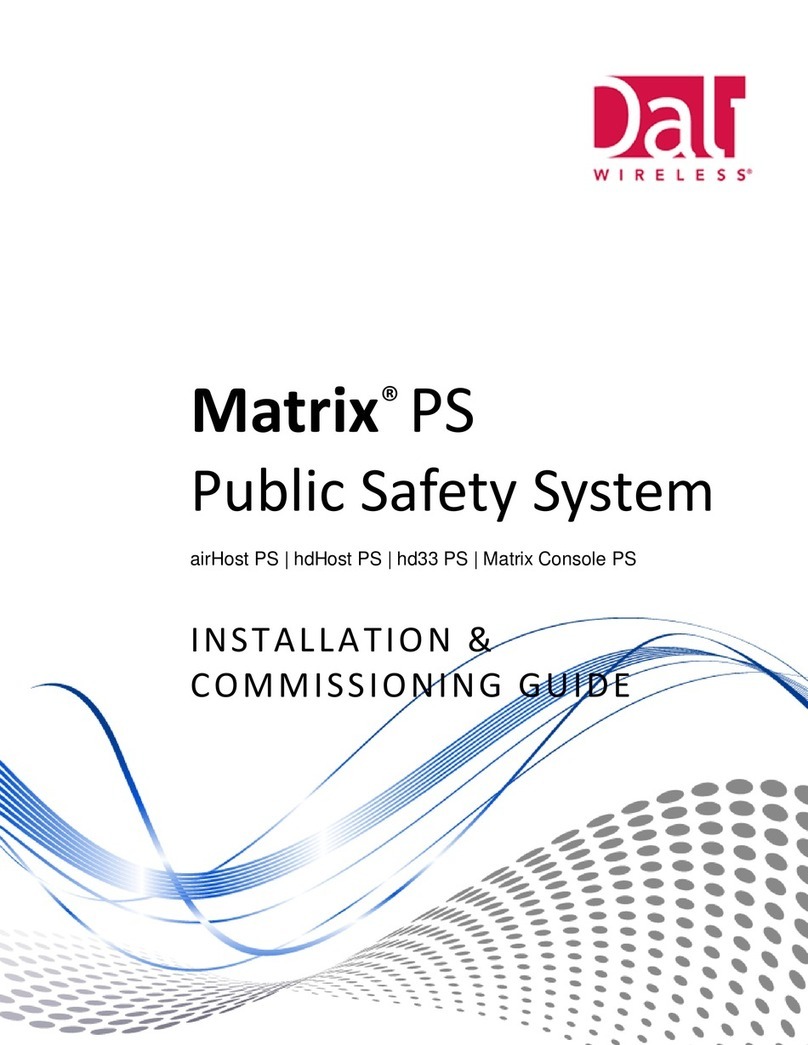
Dali Wireless
Dali Wireless Matrix PS Installation & commissioning guide

Reliance
Reliance 500 Series Instructions for use
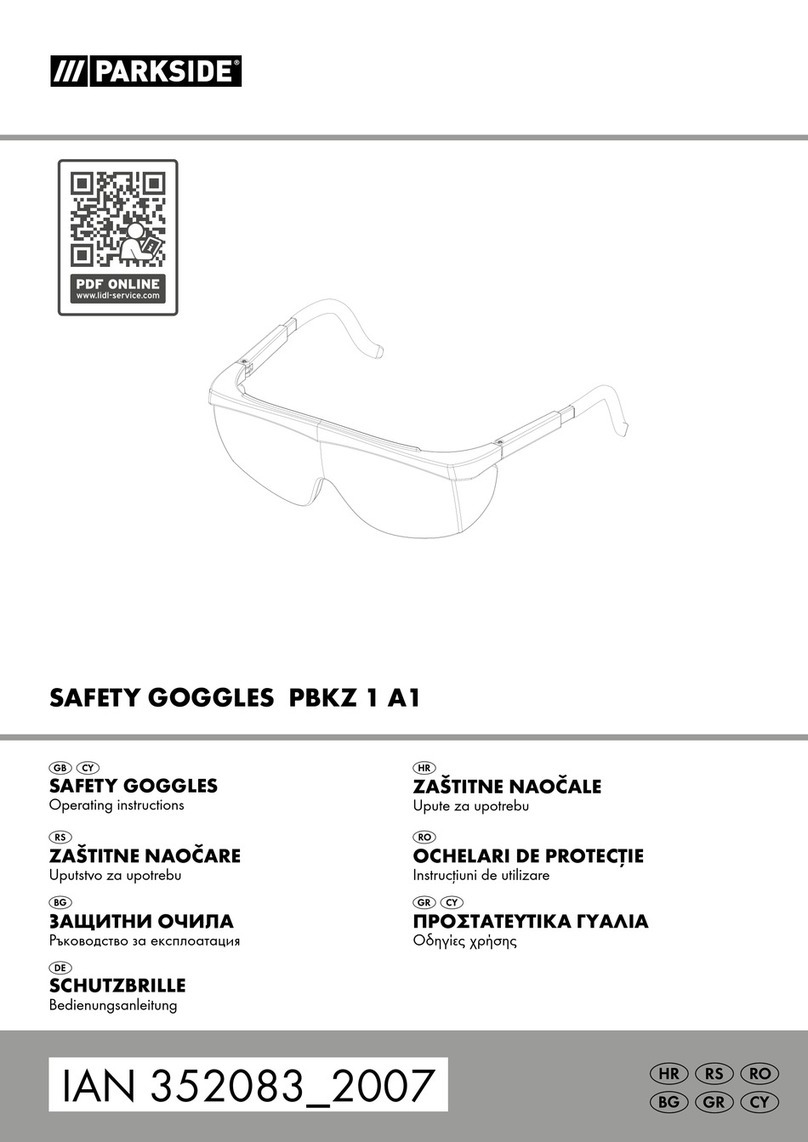
Parkside
Parkside PBKZ 1 A1 operating instructions
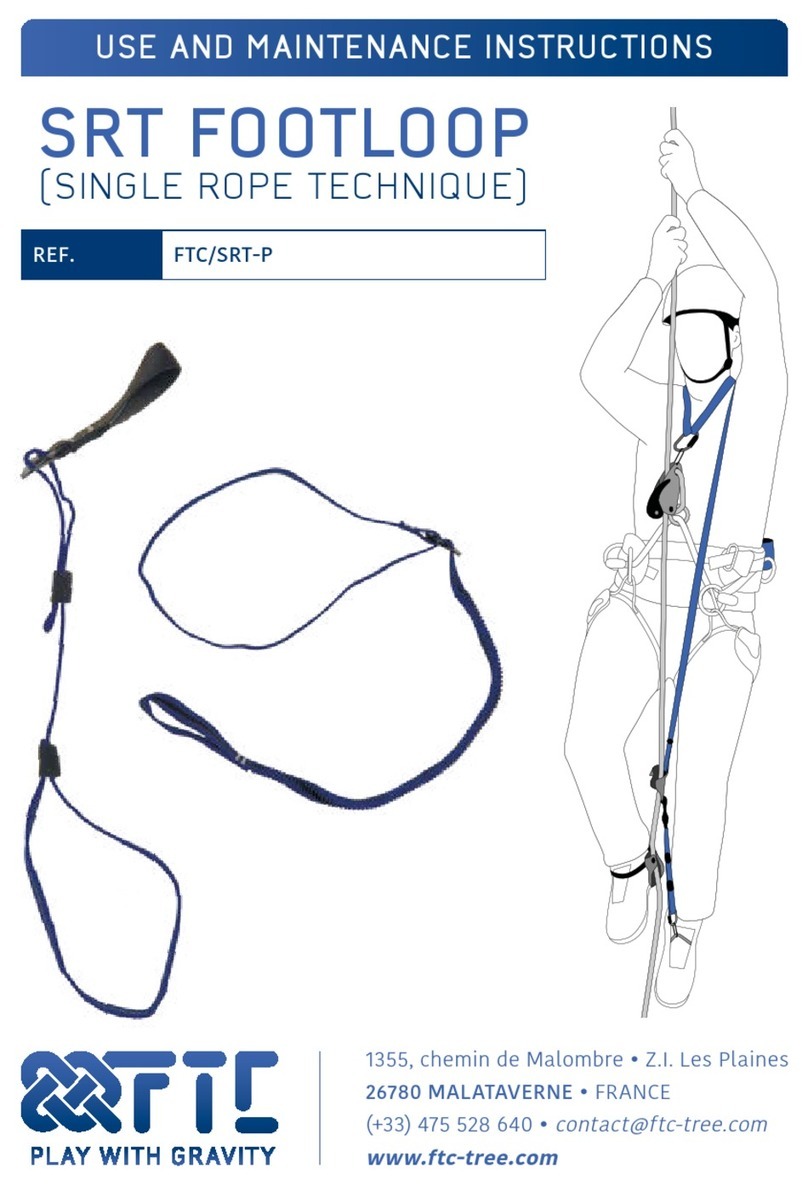
FTC
FTC SRT FOOTLOOP Use and maintenance instructions

Reer
Reer EOS2 X quick start guide
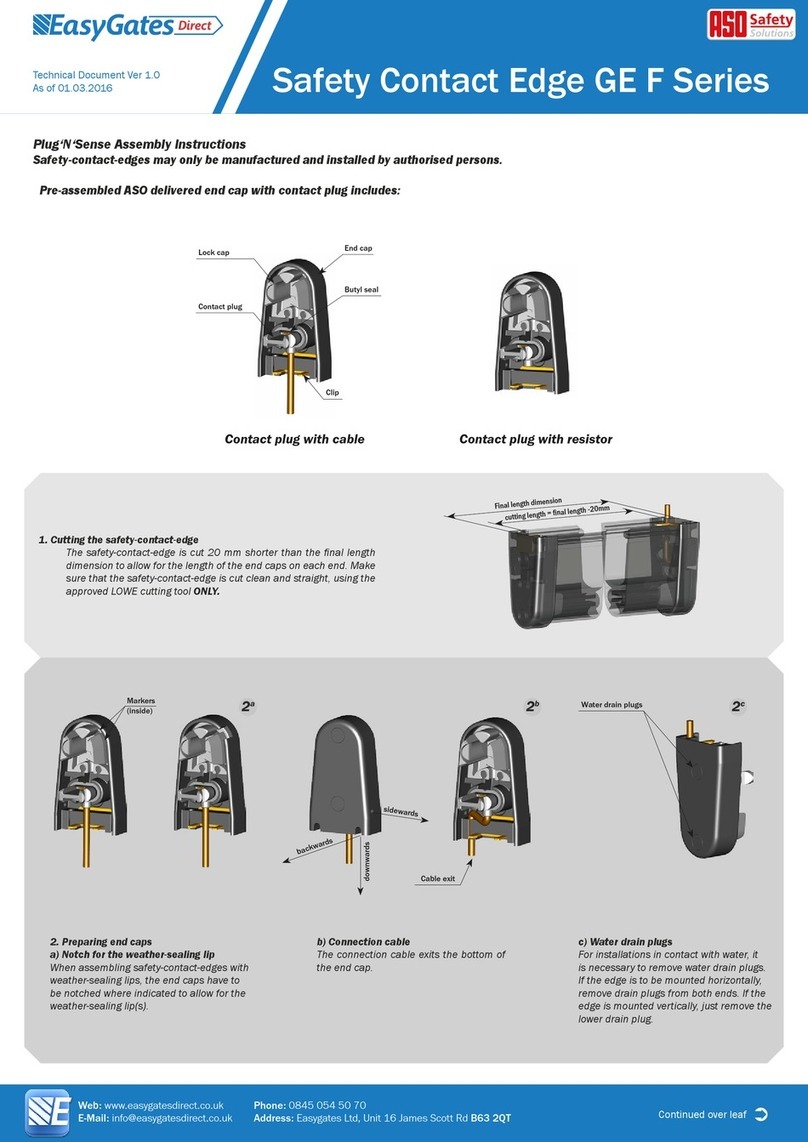
EasyGates
EasyGates ASO Safety Contact Edge GE F Series Assembly instructions

